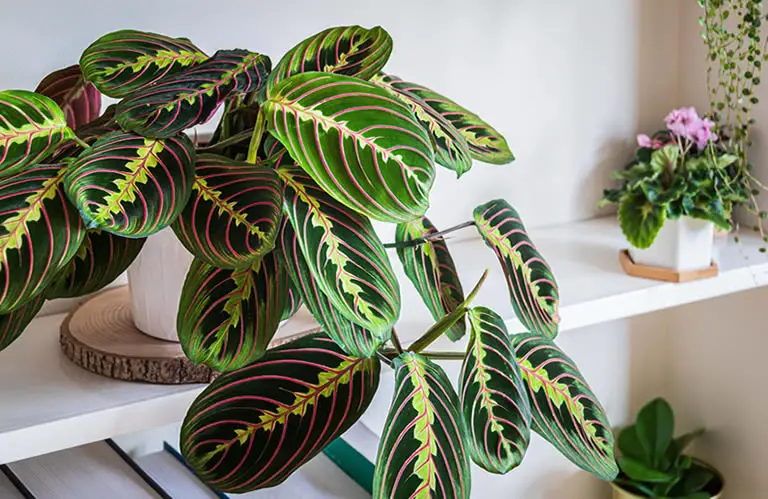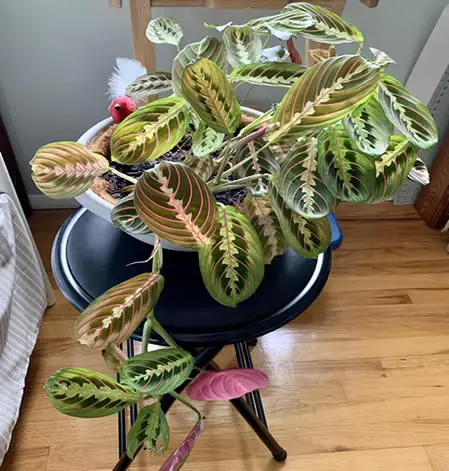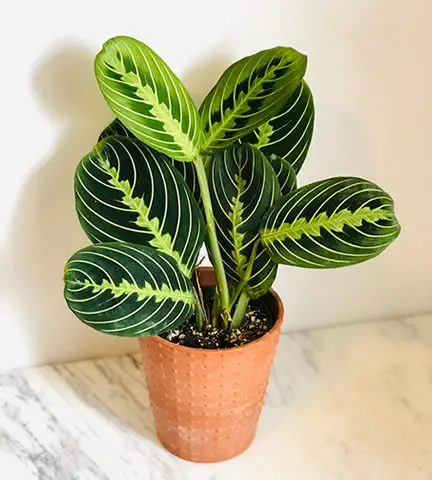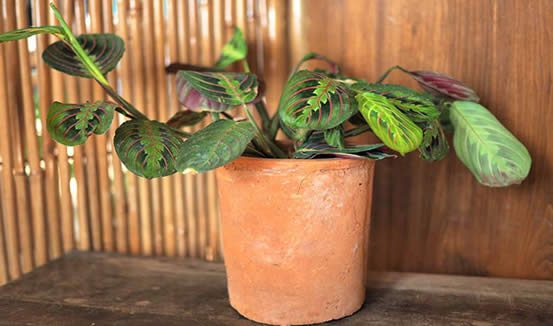Prayer Plant Care (Maranta): How to Grow a Leafy Beauty That Moves with the Light

The Prayer Plant (Maranta leuconeura) is one of the most charming houseplants you can grow. Known for its bold patterns and the way its leaves fold upward at night like hands in prayer, this plant adds color and movement to any room. With just a little care, the Prayer Plant rewards you with vibrant foliage, lively behavior, and a lush, tropical feel all year long.
Here’s how to grow a healthy Prayer Plant indoors and out, and how to troubleshoot common issues if they arise.
Table of Contents
- Filtered Light, Flawless Color: How to Light Your Prayer Plant
- Moist but Not Wet: The Right Way to Water a Prayer Plant
- Humidity and Warmth: Creating a Cozy Environment for Your Plant
- A Light Touch: Feeding and Fertilizing for Steady Growth
- Repotting and Root Space: When to Give Your Plant a Fresh Start
- Best Spot in the Home: Where Prayer Plants Shine Indoors
- Caring for Prayer Plants Outdoors: A Seasonal Treat in the Right Climate
- Common Prayer Plant Problems and How to Fix Them
- Final Thoughts
Filtered Light, Flawless Color: How to Light Your Prayer Plant
Prayer Plants thrive in bright, indirect light and will also tolerate medium light conditions.
Direct sunlight can fade the leaf patterns or cause sunburn, so it’s best to place them near a north- or east-facing window or behind sheer curtains.

If the leaves start folding tightly during the day, the light may be too strong.
Moist but Not Wet: The Right Way to Water a Prayer Plant
Keep the soil consistently moist but not soggy.
Water when the top inch feels dry and be sure to use room temperature water, ideally filtered or distilled, since Prayer Plants are sensitive to fluoride and chemicals.
In winter, reduce watering slightly, but never let the soil dry out completely.
Always use a pot with drainage holes to avoid root rot.
Humidity and Warmth: Creating a Cozy Environment for Your Plant
Prayer Plants thrive in warm, humid conditions and grow best between 65°F and 80°F.
They can suffer in dry air, especially in winter, so it helps to mist the leaves regularly, use a humidifier, or place the pot on a pebble tray.
Avoid cold drafts and sudden temperature changes, which can stress the plant and lead to leaf drop.
A Light Touch: Feeding and Fertilizing for Steady Growth
Feed your Prayer Plant every 4 to 6 weeks during spring and summer with a balanced liquid fertilizer diluted to half strength.

Skip feeding in fall and winter when growth slows.
Use a good quality 10-10-10 fertilizer, such as this one, or a 20-20-20 fertilizer, like this one.
Too much fertilizer can cause leaf tips to brown, so err on the side of caution.
Repotting and Root Space: When to Give Your Plant a Fresh Start
Prayer Plants like being a little snug in their pots, but if you notice slowed growth, root-bound signs, or water draining too quickly, it may be time to repot.
Do this in spring using fresh, well-draining potting mix rich in organic matter.
A pot just one size larger is all you need.
Best Spot in the Home: Where Prayer Plants Shine Indoors
Prayer Plants are perfect for bathrooms, bedrooms, or bright kitchens where they get plenty of filtered light and high humidity.
They also do well in living rooms near windows, especially when displayed in hanging baskets or on low shelves where their bold foliage can be admired up close.
Caring for Prayer Plants Outdoors: A Seasonal Treat in the Right Climate
In USDA zones 11–12, Prayer Plants can be grown outdoors year-round in shaded, humid garden beds.
In cooler zones, they can spend the summer outside in a protected spot with no direct sun.

Keep the soil evenly moist and be sure to transition the plant slowly when moving it outside or back in.
Bring it indoors before night temperatures drop below 60°F and rinse the leaves to keep pests from coming along for the ride.
Common Prayer Plant Problems and How to Fix Them
Browning leaf tips are usually caused by dry air, inconsistent watering, or mineral buildup in tap water
Fix it by using filtered water, keeping humidity high, and watering on a regular schedule
Curling leaves during the day may be a sign of too much light or not enough humidity
Fix it by moving the plant to a softer light source and increasing air moisture
Yellowing leaves often indicate overwatering or poor drainage
Fix it by letting the soil dry slightly more between waterings and ensuring the pot drains well
Drooping leaves can be caused by underwatering or cold drafts
Fix it by checking soil moisture and keeping the plant in a stable, warm location
Pale leaves or faded patterns may be due to too much direct sunlight
Fix it by moving the plant to a spot with filtered or indirect light
Pests like spider mites or mealybugs sometimes show up in dry conditions
Fix it by wiping leaves with a damp cloth, misting regularly, and treating with neem oil if necessary
Final Thoughts
The Prayer Plant brings a joyful energy to any room with its colorful leaves and gentle movements throughout the day.
It’s not the fussiest plant, but it does love a bit of extra humidity, consistent moisture, and a peaceful, indirect light spot.
Give it what it needs, and it will repay you with vibrancy, personality, and those magical nighttime leaf-folding rituals that never stop being fun to watch.
Let me know what plant you’d like to explore next—I’m ready when you are, always
Thanks for reading! I'm Michael — houseplant fanatic and your Pinterest plant guide.
Follow me on Pinterest for fresh updates 🌿



